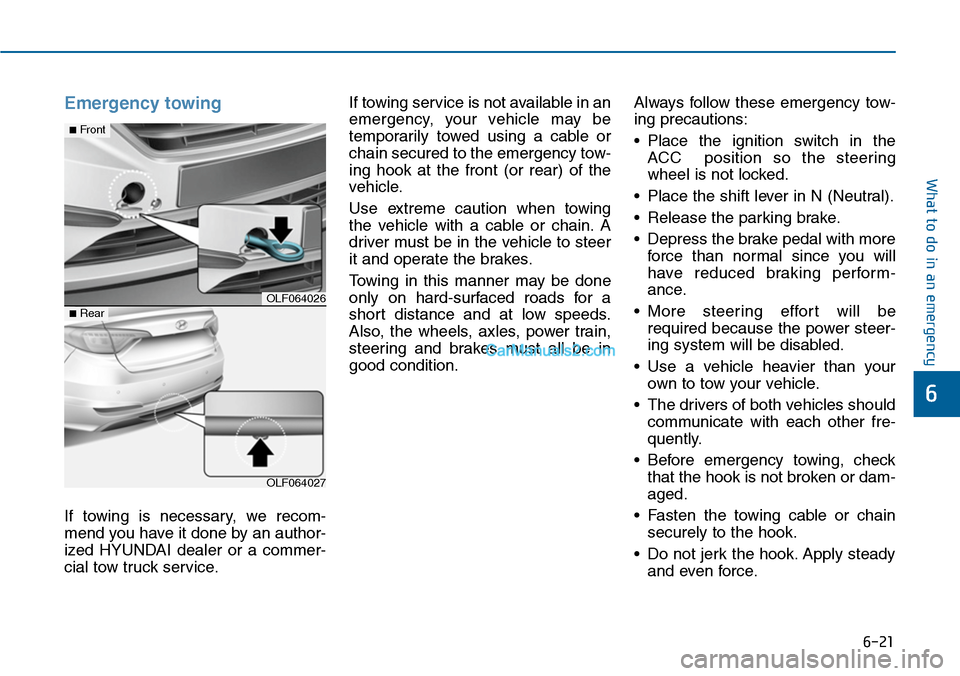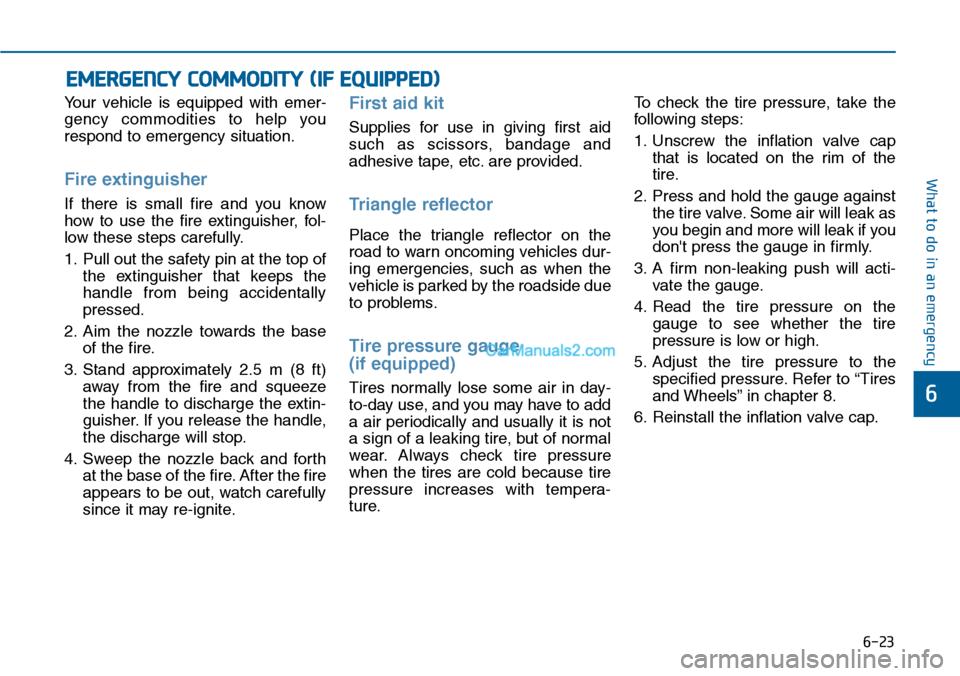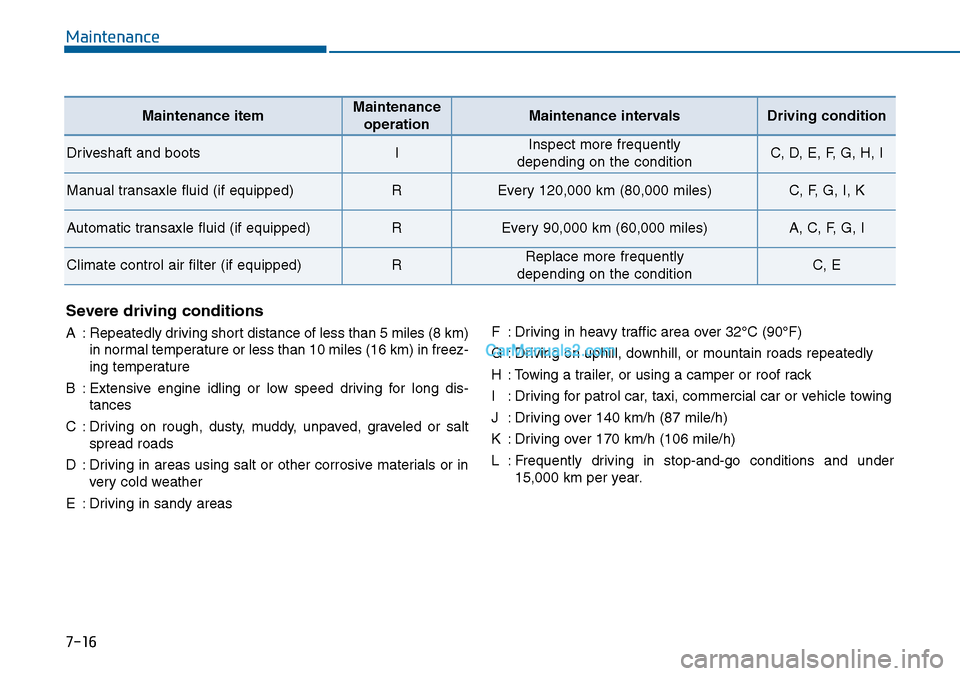Page 550 of 665

6-16
What to do in an emergency
When driving with the compact spare
tire mounted to your vehicle:
•Check the tire pressure after
installing the compact spare tire.
The compact spare tire should be
inflated to 420 kPa (60 psi).
•Do not take this vehicle through an
automatic car wash while the com-
pact spare tire is installed.
•Do not use the compact spare tire
on any other vehicle because this
tire has been designed especially
for your vehicle.
•The compact spare tire’s tread life
is shorter than a regular tire.
Inspect your compact spare tire
regularly and replace worn com-
pact spare tires with the same size
and design, mounted on the same
wheel.
•Do not use more than one compact
spare tire at a time.
•Do not tow a trailer while the com-
pact spare tire is installed.
When the original tire and wheel
are repaired and reinstalled on the
vehicle, the lug nut torque must be
set correctly. The correct lug nut
tightening torque is 9-11 kg.m (65-
79 lb.ft).
NOTICE
To prevent damaging the com-
pact spare tire and your vehicle:
•Drive slowly enough for the
road conditions to avoid all
hazards, such as a potholes
or debris.
•Avoid driving over obstacles.
The compact spare tire diame-
ter is smaller than the diame-
ter of a conventional tire and
reduces the ground clearance
approximately 25 mm (1 inch).
•Do not use tire chains on the
compact spare tire. Because
of the smaller size, a tire chain
will not fit properly.
•Do not use the compact spare
tire on any other wheels, nor
should standard tires, snow
tires, wheel covers or trim
rings be used with the com-
pact spare wheel.
CAUTION
Page 553 of 665
6-19
What to do in an emergency
6
Towing service
If emergency towing is necessary,
we recommend having it done by an
authorized HYUNDAI dealer or a
commercial tow-truck service.
Proper lifting and towing procedures
are necessary to prevent damage to
the vehicle. The use of wheel dollies
or flatbed is recommended.
It is acceptable to tow the vehicle
with the rear wheels on the ground
(without dollies) and the front wheels
off the ground.
If any of the loaded wheels or sus-
pension components are damaged
or the vehicle is being towed with the
front wheels on the ground, use a
towing dolly under the front wheels.
When being towed by a commercial
tow truck and wheel dollies are not
used, the front of the vehicle should
always be lifted, not the rear.
TOWING
OLF064021NDolly
•Do not tow the vehicle with the
front wheels on the ground as
this may cause damage to the
vehicle.
•Do not tow with sling-type
equipment. Use wheel lift or
flatbed equipment.
CAUTION
OLF064023
OLF064022
Page 554 of 665
6-20
What to do in an emergency
When towing your vehicle in an
emergency without wheel dollies:
1. Place the ignition switch in the
ACC position.
2. Place the shift lever in N (Neutral).
3. Release the parking brake.
Removable towing hook 1. Open the trunk, and remove the
towing hook from the tool case.
2. Remove the hole cover pressing
the lower part of the cover on the
front bumper.
3. Install the towing hook by turning it
clockwise into the hole until it is
fully secured.
4. Remove the towing hook and
install the cover after use.Failure to place the shift lever in
N (Neutral) may cause internal
damage to the transaxle.
CAUTION
OLF064024
OLF064025
OLF064027
■Front
■Rear
Page 555 of 665

6-21
What to do in an emergency
6
Emergency towing
If towing is necessary, we recom-
mend you have it done by an author-
ized HYUNDAI dealer or a commer-
cial tow truck service.
If towing service is not available in an
emergency, your vehicle may be
temporarily towed using a cable or
chain secured to the emergency tow-
ing hook at the front (or rear) of the
vehicle.
Use extreme caution when towing
the vehicle with a cable or chain. A
driver must be in the vehicle to steer
it and operate the brakes.
Towing in this manner may be done
only on hard-surfaced roads for a
short distance and at low speeds.
Also, the wheels, axles, power train,
steering and brakes must all be in
good condition.
Always follow these emergency tow-
ing precautions:
•Place the ignition switch in the
ACC position so the steering
wheel is not locked.
•Place the shift lever in N (Neutral).
•Release the parking brake.
•Depress the brake pedal with more
force than normal since you will
have reduced braking perform-
ance.
•More steering effort will be
required because the power steer-
ing system will be disabled.
•Use a vehicle heavier than your
own to tow your vehicle.
•The drivers of both vehicles should
communicate with each other fre-
quently.
•Before emergency towing, check
that the hook is not broken or dam-
aged.
•Fasten the towing cable or chain
securely to the hook.
•Do not jerk the hook.Apply steady
and even force.
OLF064026
OLF064027
■Front
■Rear
Page 556 of 665
6-22
What to do in an emergency
•Use a towing cable or chain less
than 5 m (16 feet) long. Attach a
white or red cloth (about 30 cm (12
inches) wide) in the middle of the
cable or chain for easy visibility.
•Drive carefully so the towing cable
or chain remains tight during tow-
ing.
•Before towing, check the automat-
ic transaxle for fluid leaks under
your vehicle. If the automatic
transaxle fluid is leaking, flatbed
equipment or a towing dolly must
be used.
To avoid damage to your vehicle
and vehicle components when
towing:
•Always pull straight ahead
when using the towing hooks.
Do not pull from the side or at
a vertical angle.
•Do not use the towing hooks
to pull a vehicle out of mud,
sand or other conditions from
which the vehicle cannot be
driven out under its own
power.
•Limit the vehicle speed to
15 km/h (10 mph) and drive
less than 1.5 km (1 mile) when
towing to avoid serious dam-
age to the automatic
transaxle.
CAUTION
ODH063025
Page 557 of 665

6-23
What to do in an emergency
6
Yo u r v e h i c l e i s e q u i p p e d w i t h e m e r -
gency commodities to help you
respond to emergency situation.
Fire extinguisher
If there is small fire and you know
how to use the fire extinguisher, fol-
low these steps carefully.
1. Pull out the safety pin at the top of
the extinguisher that keeps the
handle from being accidentally
pressed.
2. Aim the nozzle towards the base
of the fire.
3. Stand approximately 2.5 m (8 ft)
away from the fire and squeeze
the handle to discharge the extin-
guisher. If you release the handle,
the discharge will stop.
4. Sweep the nozzle back and forth
at the base of the fire. After the fire
appears to be out, watch carefully
since it may re-ignite.
First aid kit
Supplies for use in giving first aid
such as scissors, bandage and
adhesive tape, etc. are provided.
Triangle reflector
Place the triangle reflector on the
road to warn oncoming vehicles dur-
ing emergencies, such as when the
vehicle is parked by the roadside due
to problems.
Tire pressure gauge
(if equipped)
Tires normally lose some air in day-
to-day use, and you may have to add
a air periodically and usually it is not
a sign of a leaking tire, but of normal
wear. Always check tire pressure
when the tires are cold because tire
pressure increases with tempera-
ture.
To check the tire pressure, take the
following steps:
1. Unscrew the inflation valve cap
that is located on the rim of the
tire.
2. Press and hold the gauge against
the tire valve. Some air will leak as
you begin and more will leak if you
don't press the gauge in firmly.
3. A firm non-leaking push will acti-
vate the gauge.
4. Read the tire pressure on the
gauge to see whether the tire
pressure is low or high.
5. Adjust the tire pressure to the
specified pressure. Refer to “Tires
and Wheels” in chapter 8.
6. Reinstall the inflation valve cap.
EMERGENCY COMMODITY (IF EQUIPPED)
Page 573 of 665

Maintenance
7-16
Severe driving conditions
A:Repeatedly driving short distance of less than 5 miles (8 km)
in normal temperature or less than 10 miles (16 km) in freez-
ing temperature
B:Extensive engine idling or low speed driving for long dis-
tances
C:Driving on rough, dusty, muddy, unpaved, graveled or salt
spread roads
D:Driving in areas using salt or other corrosive materials or in
ver y cold weather
E:Driving in sandy areas
F:Driving in heavy traffic area over 32°C (90°F)
G:Driving on uphill, downhill, or mountain roads repeatedly
H:Towing a trailer, or using a camper or roof rack
I:Driving for patrol car, taxi, commercial car or vehicle towing
J:Driving over 140 km/h (87 mile/h)
K:Driving over 170 km/h (106 mile/h)
L:Frequently driving in stop-and-go conditions and under
15,000 km per year.
Maintenance itemMaintenance
operationMaintenance intervalsDriving condition
Driveshaft and bootsIInspect more frequently
depending on the conditionC, D, E, F, G, H, I
Manual transaxle fluid (if equipped)REvery 120,000 km (80,000 miles)C, F, G, I, K
Automatic transaxle fluid (if equipped)REvery 90,000 km (60,000 miles)A, C, F, G, I
Climate control air filter (if equipped)RReplace more frequently
depending on the conditionC, E
Page 579 of 665

Maintenance
7-22
Severe driving conditions
A:Repeatedly driving short distance of less than 5 miles (8 km)
in normal temperature or less than 10 miles (16 km) in freez-
ing temperature
B:Extensive engine idling or low speed driving for long distances
C:Driving on rough, dusty, muddy, unpaved, graveled or salt
spread roads
D:Driving in areas using salt or other corrosive materials or in
ver y cold weather
E:Driving in sandy areas
F:Driving in heavy traffic area over 32°C (90°F)
G:Driving on uphill, downhill, or mountain roads repeatedly
H:Towing a trailer, or using a camper or roof rack
I:Driving for patrol car, taxi, commercial car or vehicle towing
J:Driving over 140 km/h (87 mile/h)
K:Driving over 170 km/h (106 mile/h)
L:Frequently driving in stop-and-go conditions
Maintenance itemMaintenance
operationMaintenance intervalsDriving condition
Disc brakes and pads, calipers and rotorsIInspect more frequently
depending on the conditionC, D, E, G, H
Par king brakeIInspect more frequently
depending on the conditionC, D, G, H
Driveshaft and bootsIInspect more frequently
depending on the conditionC, D, E, F, G, H, I
Manual transaxle fluid (if equipped)REvery 120,000 km (80,000 miles)C, F, G, I, K
Automatic transaxle fluid (if equipped)REvery 100,000 km (62,000 miles)A, C, F, G, I
Climate control air filter (if equipped)RReplace more frequently
depending on the conditionC, E